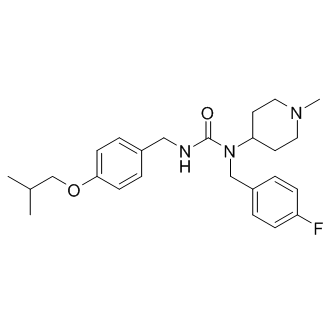
Pimavanserin displays nanomolar potency as a 5-HT2A receptor inverse agonist, selectivity for 5-HT2A over 5-HT2C receptors, and no meaningful activity at any other G-protein coupled receptor. Pimavanserin demonstrates robust activity in preclinical models of schizophrenia and PDP, and do not worsen motoric symptoms, in contrast to the APDs tested. Pimavanserin showes highly significant benefits in the primary endpoint, the scale for assessment of positive symptoms-PD, a scale adapted for use in PDP. Pimavanserin is safe and well-tolerated with long-term use.

Neurotherapeutics. 2024 Feb 16;21(2):e00334.
Neurophysiological treatment effects of mesdopetam, pimavanserin and clozapine in a rodent model of Parkinson's disease psychosis
Pimavanserin purchased from AbMole
| Cell Experiment | |
|---|---|
| Cell lines | NIH-3T3 cells |
| Preparation method | Receptor Selection and Amplification Technology. In brief, NIH-3T3 cells were grown to 80% confluence in Dulbecco's modified Eagle's medium (DMEM) supplemented with 10% bovine calf serum (Hyclone Laboratories, Logan, UT) and 1% penicillin/streptomycin/glutamine (Invitrogen, Carlsbad, CA). Cells were transfected in roller bottles for 18 h with the relevant G protein-coupled receptor gene and the gene for β-galactosidase. After transfection, cells were trypsinized, harvested, and frozen. Aliquots of frozen cell batches were thawed and tested for response to reference agonists and inverse agonists ensuring pharmacologically appropriate responses. To initiate an assay, cells were thawed rapidly and prepared in DMEM contained 0.4% calf serum (Hyclone Laboratories), 30% UltraCulture (BioWhittaker, Rockland, ME), and 1% penicillin/streptomycin/glutamine, and then they were added to half-area 96-well microtiter plates containing either test compounds or reference ligands. After 5 days in culture, media were removed from the wells, and the cells were incubated at room temperature in 200 μl of phosphate-buffered saline, pH 7.4, with 3.5 mM o-nitrophenyl-β-d-galactopyranoside (Sigma-Aldrich, St. Louis, MO) and 0.5% Nonidet P-40 (Sigma-Aldrich). After 2 to 4 h, the plates were read at 420 nm on a plate-reader (Bio-Tek Instruments, Winooski, VT). |
| Concentrations | 0~10 μM |
| Incubation time | 5 days |
| Animal Experiment | |
|---|---|
| Animal models | DOI head-twitch experiments in rats and Non-Swiss albino mice |
| Formulation | 0.9% saline |
| Dosages | 1, 3 or 10 mg/kg |
| Administration | s.c. or p.o. |
| Molecular Weight | 427.55 |
| Formula | C25H34FN3O2 |
| CAS Number | 706779-91-1 |
| Solubility (25°C) | DMSO 10 mM |
| Storage |
Powder -20°C 3 years ; 4°C 2 years In solvent -80°C 6 months ; -20°C 1 month |
| Species | Mouse | Rat | Rabbit | Guinea pig | Hamster | Dog |
| Weight (kg) | 0.02 | 0.15 | 1.8 | 0.4 | 0.08 | 10 |
| Body Surface Area (m2) | 0.007 | 0.025 | 0.15 | 0.05 | 0.02 | 0.5 |
| Km factor | 3 | 6 | 12 | 8 | 5 | 20 |
| Animal A (mg/kg) = Animal B (mg/kg) multiplied by | Animal B Km |
| Animal A Km |
For example, to modify the dose of Compound A used for a mouse (20 mg/kg) to a dose based on the BSA for a rat, multiply 20 mg/kg by the Km factor for a mouse and then divide by the Km factor for a rat. This calculation results in a rat equivalent dose for Compound A of 10 mg/kg.
| Related 5-HT Receptor Products |
|---|
| TC-2153
TC-2153 is a selective inhibitor of striatal-enriched protein tyrosine phosphatase (STEP). TC-2153 also inhibits 5-HT2A receptor-mediated signaling. |
| Gentisein
Gentisein (NSC-329491), the major metabolite of Mangiferin, shows the most potent serotonin uptake inhibition with an IC50 value of 4.7 µM. |
| MM120
MM120 is a synthetic tryptamine that is also a partial agonist at the 5-hydroxytryptamine 2A (5-HT2A) receptor. It can be used in studies related to GAD and attention deficit hyperactivity disorder (ADHD). |
| SB 258741 hydrochloride
SB 258741 hydrochloride is a specific 5-HT7 receptor antagonist for schizophrenia. |
| 5-HT1A antagonist 1
5-HT1A antagonist 1 is a potent and selective 5-HT1A receptor antagonist with a Ki value of 35 nM.5-HT1A antagonist 1 can be used in the study of central nervous system disorders. |


Products are for research use only. Not for human use. We do not sell to patients.
© Copyright 2010-2023 AbMole BioScience. All Rights Reserved.
